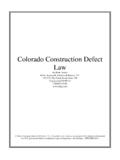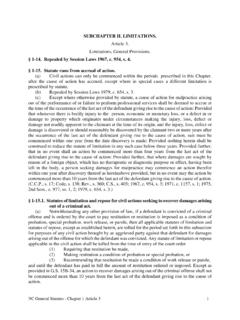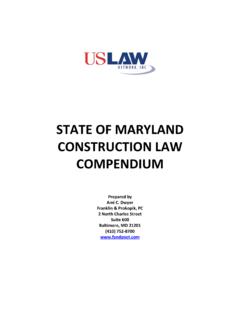Transcription of Colorado Construction Defect Law
1 Colorado Construction Defect Law By Mark Neider Harris, Karstaedt, Jamison & Powers, 10333 E. Dry Creek Road, Suite 300. Englewood CO 80112. (720)875-9140. Harris, Karstaedt, Jamison & Powers, , Copyright is not claimed as to any part of the original work prepared by a government officer or employee as part of that person's official duties. UPDATED 2011. TABLE OF CONTENTS. 1 OVERVIEW OF Colorado LAW .. 1. Common Law .. 1. Statutory Law .. 2. 2 Construction PROFESSIONALS SUBJECT TO Construction . LITIGATION .. 3. Builder-Vendor .. 3. General Contractor / Custom Builder .. 3. Subcontractors and Third Party Claims .. 3. Design Professionals .. 4. The Liability Burdening Agents of Construction Professionals and the Apparent Authority Doctrine .. 4. Developers.
2 4. 3 THEORIES OF RECOVERY .. 5. Breach of Contract .. 5. Breach of Express Warranty .. 5. Breach of Implied Warranties .. 6. Negligence .. 6. Economic Loss Rule Versus the Independent Duty .. 7. Misrepresentation or Concealment .. 8. Indemnification/Contribution .. 9. Soils Disclosures .. 10. Colorado Consumer Protection Act ( CCPA ) .. 10. Civil Conspiracy .. 11. 4 DEFENSES .. 12. Construction Defect / Bodily Injury .. 12. Statutes of Limitations/Repose .. 12. Claim Accrual .. 12. Two Year Statute of Limitation .. 13. Six Year Conditional Statute of Limitations .. 13. Eight Year Statute of Repose .. 14. Repair Doctrine/Equitable Tolling .. 14. Ninety Day Statutory Tolling of Third Party Claims .. 15. Consumer Protection Act Statute of Limitation.
3 15. Breach of Warranty Statute of Limitations .. 15. Product Liability Act .. 15. Exculpatory Clauses / Waiver .. 16. Duty to Mitigate .. 16. i 5 DAMAGES .. 16. Common Law Measure of Damages .. 17. Statutory Measure of Damages / Actual Damages .. 17. Contract Damages .. 18. Allocation of Damages .. 19. Treble Damages Under the CCPA and CDARA .. 19. Punitive / Exemplary Damages .. 19. Attorney Fees .. 19. Prejudgment Interest .. 20. 6 Colorado COMMON INTEREST COMMUNITY ACT / HOA DERIVATIVE. MEMBERSHIP STANDING .. 21. 7 ALTERNATE DISPUTE RESOLUTION / ARBITRATION .. 22. Notice of Claim Procedure .. 23. Initial Defect List .. 24. 8 INSURANCE .. 24. Continuous Occurrence/Trigger and Time On Risk .. 24. Pleading an Occurrence That Gives Rise to the Insurer's Duty to Defend.
4 25. Coverage for Known Losses/ Montrose Clauses .. 25. Business Risk and the Work Product Exclusion .. 26. Additional Insured Coverage for Construction defects .. 26. 9 CONCLUSION .. 27. TABLE OF AUTHORITY .. 28. ii 1 OVERVIEW OF Colorado LAW. Many of the standards and rules governing Construction Defect law in the State of Colorado arise out of the public policy that a builder is in a better position than the consumer to ensure that the Construction of a residence is suitable. In the case of Sloat v. Methany, 625 1031, 1033 ( ) the Colorado Supreme Court remarked as follows: the rule of caveat emptor .. was based upon an arms-length transaction between the seller and buyer and contemplated comparable skill and experience, which does not now exist; they are not in an equal bargaining position and the buyer is forced to rely on the skill and knowledge of the builder.
5 The position of the builder-vendor, as compared to the buyer, dictates that the builder bear the risk that the house is fit for its intended use. Another rationale for the rule is to inhibit the unscrupulous, fly-by-night, or unskilled builder and to discourage much of the sloppy work and jerry building that has become perceptible over the years. Based on the disparity of expertise and bargaining power between builder and home buyer, Colorado law has developed a number of mechanisms to manage the disputes arising out of residential Construction . Unlike residential Construction , the duties owed between parties to a commercial Construction project are dictated by contractual relationships where no duty independent of the contract is owed. See BRW, Inc.
6 V. Dufficy & Sons, Inc. 99 66. ( )(holding design professional did not owe steel subcontractor any duty independent of contract). Despite this strict contractual approach, Colorado has also devised certain statutory schemes that govern rights between parties to a commercial or public works project. As discussed below, the letter of the law governing Construction Defect litigation arises both out of common law and statute enacted by Colorado 's General Assembly. While many of these laws are fairly straightforward, many more are open to ongoing debate as to how these concepts should be applied to achieve fair and equitable results. This survey is intended to provide a simplified overview of how Construction Defect laws operate for the benefit or detriment of builders, contractors and consumers alike.
7 Common Law The common law governing Construction Defect litigation in Colorado has been developed through decades of legal precedent. Over time, Colorado has come to recognize that a Construction dispute may arise based on claims of negligence, breach of the implied warranty of habitability, breach of express warranties and breach of contract. The operation of these theories of recovery as well as applicable affirmative defenses are discussed in further detail below. 1. Statutory Law Based on the increasing liability builders face in the State of Colorado from dynamic geotechnical conditions and the harsh alpine environment, Colorado 's General Assembly has passed laws in an attempt to regulate claims regarding builder liability for Construction defects .
8 One of the first such laws, passed in 1984, was the soils disclosure statute. Under the soils disclosure at , a builder must provide its consumers a summary report of any impact expansive soils may have on residential structure and a publication detailing Construction means and methods used to address the unique hazards presented by those soils. The Colorado Construction Defect Action Reform Act at 13-20-801, et seq. ( CDARA ) passed in 2001 was a landmark development in Construction Defect law. CDARA. was initially enacted by a coalition interested in preserving adequate rights and remedies for property owners who bring and maintain claims of Construction defects . 13-20-802, Under the original Act, an owner was required to provide contractors a list of defects for which damages were sought within sixty days of commencement of suit.
9 13-20-803, A. claimant could only recover damages for actual or probable damages to real property, loss of use or bodily injury. 13-20-804, It also changed the law to state that builders could reserve on claims against third-party subcontractors or design professionals until after settlement or judgment so they would not risk losing their claims under the statute of limitations. 13-80-104, Finally, the initial Act amended the Colorado Common Interest Ownership Act at 38- , ( CCIOA ) to require homeowner associations to disclose claims of Construction defects it asserted in litigation to its members and any prospective buyers of units within the association. Only two years later, the political climate in Colorado changed and CDARA was revised primarily for the purpose of limiting a builder's liability.
10 As discussed in greater detail below, numerous revisions were made to reduce the measure and character of damages claimed against builders. Among the more important revisions made were limitations on a builder's liability for treble damages under the Colorado Consumer Protection Act at 6-1-101, ( CCPA ), the imposition of a notice of claim procedure intended to afford a builder the opportunity to resolve a dispute prior to the initiation of litigation, and a reduction in the measure of damages for a Construction Defect . In 2007, the political pendulum swung back to align with the interests of home buyers with the enactment of the Homeowner Protection Act, added by Laws 2007, Ch. 164 at 1, eff. April 20, 2007 ( HPA ). While the HPA changed several components of Construction Defect litigation, the most important applied to waivers of builder liability typically contained in a builder's buy/sell agreement in consideration of builder providing an express limited warranty.










